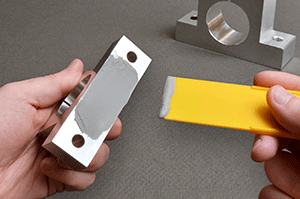
 Because of its outstanding strength and other physical properties, Master Bond Supreme 10HT has been selected for use in several published research studies. Following are summaries of how Supreme 10HT performed in demanding applications outlined in these studies.
Because of its outstanding strength and other physical properties, Master Bond Supreme 10HT has been selected for use in several published research studies. Following are summaries of how Supreme 10HT performed in demanding applications outlined in these studies.
Control electronics packaging
A study conducted at L’École Polytechnique Fédérale de Lausanne (EPFL) in Lausanne, Switzerland, investigated alternative materials for use in high temperature control electronics packaging.1 Master Bond Supreme 10HT was one of the adhesives tested in the study.
In high temperature testing, five samples were subjected to 210°C (410°F) temperatures in a process oven. All samples were removed after 24 hours, and one die from each sample was shear tested. Results showed that the strength of the Supreme 10HT samples increased progressively after 24 hours. Although the strength of the bond decreased after 1000 hours of heat exposure, it still exceeded the minimum 2.4 Kg force threshold stipulated by MIL-STD-883H method 2019.8.
In thermal cycling tests samples were subjected to repeated temperature cycling between 20°C and 180°C. Shear tests were performed on one die from each sample after both 10 and 100 cycles. The Supreme 10HT samples showed no measurable degradation in bond strength after either 10 or 100 cycles, even under a maximum strain of 200μm.
Read case study on control electronics packaging.
Mixed adhesive joint for supersonic aircraft
A research team from the University of Porto (Portugal) and the University of Bristol (UK) set out to investigate the possibility of designing a mixed-adhesive joint consisting of both a low-temperature adhesive and a high-temperature adhesive that would support the required load across the entire temperature range.2 Results showed that Supreme 10HT maintained sufficient stiffness, strength, and ductility to carry a load over the temperature range from 55°C to 100°C and higher.
Read case study on mixed adhesive joint for supersonic airfcraft.
Capacitor Tanks
Researchers at Cooper Technologies Company in Houston, Texas, ran performance tests on over a dozen commercially available epoxy resin products in an effort to identify compositions that may be used to seal capacitor tanks.3 First, the lap shear strength was determined for each product, both at a high temperature (75°C–90°C) and at room temperature (25°C). With a lap shear strength of 3782 psi at high temperature and 3006.92 psi at room temperature, Master Bond Supreme 10HT epoxy was cited as one of only four products that exhibited sufficient strength for the application.
Read case study on capacitor tanks.
Sources
1Slater, C., et al. “Packaging technologies for high temperature control electronics,” Proceedings, International Conference and Exhibition on High Temperature Electronics Network (HiTEN) , vol. 2013, Jan. 2013, pp. 184-192. doi: 10.4071/HITEN-TP15. Accessed 26 Apr. 2018.
2Da Silva, L. F. M. and Adams, R.D. “Measurement of the mechanical properties of structural adhesives in tension and shear over a wide range of temperatures,” Journal of Adhesion Science and Technology, 2005, vol. 19, no. 2, pp. 109-141. doi: 10.1163/1568561053148449. Accessed 2 May 2018.
3Li, C., et al. “Joining dissimilar materials using an epoxy resin composition.” US Patent 9,761,374 B2. 12 Sept. 2017.
